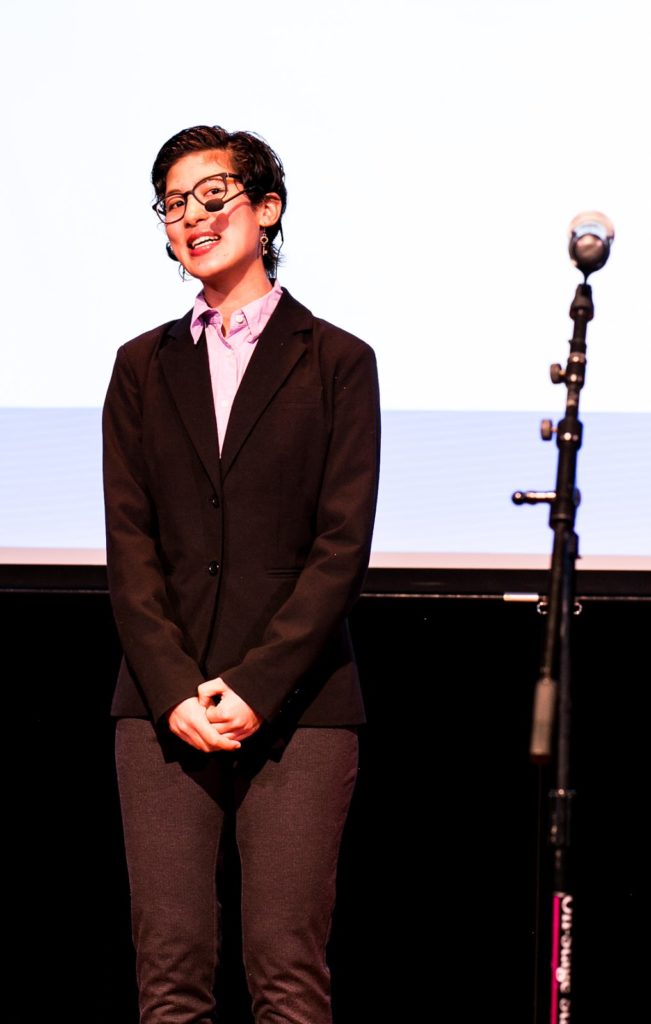RESOURCE 4
Theories About Facing the Fear
S1E2: How We Faced the Fear
Public speaking is scary, but somehow we make it through. Two high school students, Lindsey Lam and Ava Remler, describe what they did to overcome their fear of public speaking. AnnMarie Baines, Executive Director of The Practice Space, connects their stories to broader research on communication anxiety, reminding us that we aren't alone.
 Public speaking is often scary because it feels overwhelming and daunting to even figure out how to begin facing the fear. The fear of public speaking is often cited as being our number one fear, even before death. While this actually isn’t true (the original source of that particular statistic was the comedian Jerry Seinfeld), it is up there. According to the National Institute of Mental Health, over 15 million Americans suffer from social anxiety, which affects men and women equally and tends to begin by age 13. The fear of public speaking falls under the category of “communication apprehension”, which is fear or anxiety experienced by a person due to real or perceived communication with another person. You feel anxious communicating with others.
Public speaking is often scary because it feels overwhelming and daunting to even figure out how to begin facing the fear. The fear of public speaking is often cited as being our number one fear, even before death. While this actually isn’t true (the original source of that particular statistic was the comedian Jerry Seinfeld), it is up there. According to the National Institute of Mental Health, over 15 million Americans suffer from social anxiety, which affects men and women equally and tends to begin by age 13. The fear of public speaking falls under the category of “communication apprehension”, which is fear or anxiety experienced by a person due to real or perceived communication with another person. You feel anxious communicating with others.
As highlighted by Louisiana State Professor of Communication Studies, Graham Bodie, in his review of studies about the fear of public speaking, our fears can be divided into two categories. Sometimes, the fear of public speaking is part of a general trait, a tendency to experience anxiety related to any kind of communication. Other times, it depends on the state, where our anxiety occurs only in specific situations and time. In terms of situations that raise our anxiety, Psychology Today says this depends on whether we are being evaluated, whether there is a substantial difference in status or power, whether the ideas we are communicating are new to us, and whether we are speaking in front of a new audience.
Regardless of category, the most common trigger of this anxiety is whether we are in a new or uncertain situation -- unfortunately, for many of us who don’t have to speak that often, public speaking is new and uncertain. When faced with an audience, we release the same physiological response as when faced with a wild animal, with all the hormones, cortisol, adrenaline that accompany that reaction. Other common triggers include the fear of being judged and the negative thoughts we tell ourselves about what others think about us.
In these situations, the majority of people in the United States use the avoidance coping strategy -- just don’t do it. But at what cost? We are caught in a dilemma: when we avoid communication, we are severely limited in how we can interact and live. But we can never truly eliminate anxiety, even when we try. What we can do though, is change how we think about public speaking and push for support systems that buffer these fears, especially for people of color or groups who have been historically marginalized.
Theories about Addressing Fear
The University of Minnesota’s “Communication in the Real World” lists three methods for facing the fear of public speaking: 1) systematic desensitization; 2) cognitive restructuring; and 3) skills training. What this means is that we become less anxious when we are more exposed to something, when we change the way we think about something, and when we have the tools to do something about our situation.
Sometimes, it helps to remind yourself that the negative consequences of any moment of communication aren’t as bad as we think and instead visualize it going well. It lowers anxiety to think of public speaking as a conversation that aims to express your ideas or tell your story, rather than a performance that will be judged. Physical relaxation exercises and self-talk statements can also be used to remind us of what is really important.
The communication studies research also highlights the importance of having quality information and topics we know deeply: we are more confident when we know what we are talking about. It is also important to have practice and feedback from a trusted source and have very specific ways of assessing whether we did well. Rather than just judging our public speaking based on the awful memories we have of the experience -- we will always think we did badly -- we need to instead define what success means in advance and evaluate ourselves based on those specific definitions.
Unfortunately, many of the suggestions from the realm of social psychology focus more on internal anxiety barriers, as opposed to the external institutional barriers stemming from systemic oppression. When people of color have to speak up in situations where their voices are unwelcome or where they will be greeted by suspicion and discrimination, fear goes beyond emotional discomfort and enters the high-stakes realm of risk and real harm. vExposure to public speaking is limited when not everyone is privileged enough to be invited to speak and it is difficult for someone to visualize something going well without seeing role models who look like them. Having to speak in front of an audience in a non-native language adds an additional layer of uncertainty and fear. Addressing these fears must include an entire ecosystem, where allies, families, colleagues, and support systems are in place to provide opportunities to practice and mentorship to build confidence. In her 2002 book, Nilda Flores-Gonzalez calls for community contexts to create networks of support that buffer the negative impacts of stereotyping and recognize the effects of prejudice, mistrust, and blame.
The Final Takeaway
Changing the way we think about our fear of public speaking involves coming up with statements that remind us that there is something more important than our fear. Remind yourself that the work and the message are more important than your nerves, but that sometimes, you cannot embrace these fears alone, especially if you are facing a harmful and dangerous context. Even in the face of danger and fear, we have to remind ourselves why our stories are important to tell. The fear never goes away, but hopefully we can build support systems to help us put it aside, just for a little while, while we express what matters.


